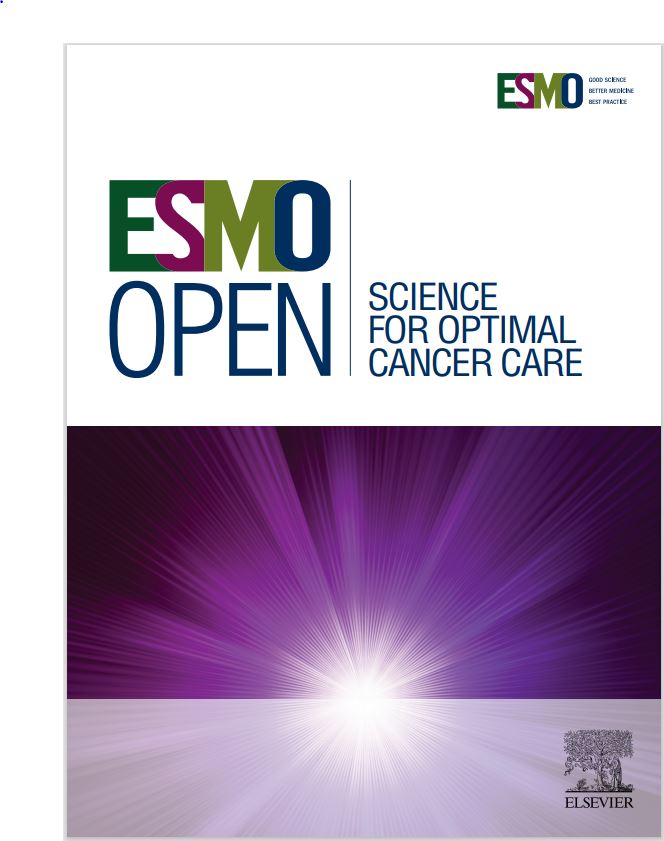CDK4/6 inhibition in advanced chordoma: final results of the NCT PMO-1601 trial
IF 7.1
2区 医学
Q1 ONCOLOGY
引用次数: 0
Abstract
Background
This study aims to evaluate antitumor response of palbociclib in patients with advanced chordoma, an ultra-rare cancer without approved systemic therapy. Previous data showed that palbociclib reduced cell viability and proliferation in CDKN2A-deficient chordoma cell lines.
Patients and methods
We conducted a phase II single-arm, open-labeled trial on palbociclib in adult patients with advanced chordomas with p16 (by immunohistochemistry) or CDKN2A (by genomic analysis) loss along with retained CDK4/6 and RB1 expression (by immunohistochemistry or RNA sequencing). Based on CDK4/6/pRB (S780) immunohistochemical expression patterns, a responder versus non-responder signature was assigned. The study used a Simon optimal two-stage design with the primary endpoint of disease control rate (DCR) by RECISTv1.1 after six cycles. Secondary endpoints included progression-free survival, overall survival, and biomarker analysis. The study was considered positive if 25% of patients reached the primary endpoint.
Results
Twenty-eight patients with a median age of 59 years were assessed for the primary endpoint. After a median follow-up of 28 months, the DCR was 39%, with 11 patients achieving stable diseases. No objective responses were obtained. The median progression-free survival was 5.6 months, and the median overall survival was 24.6 months. Treatment was well tolerated without new safety signals. There was no correlation between immunohistochemical responder phenotypes and outcome. Biomarker analysis identified additional clinically actionable alterations affecting PIK3CA, PTEN, MTAP, or MET genes, and druggable pathways by transcriptomic analysis.
Conclusion
Although antitumor activity was modest, the trial met its primary endpoint. Molecularly tailored combination therapies should be considered in the future to improve efficacy.
CDK4/6抑制晚期脊索瘤:NCT PMO-1601试验的最终结果
本研究旨在评估帕博西尼在晚期脊索瘤患者中的抗肿瘤反应,脊索瘤是一种尚未批准全身治疗的超罕见癌症。先前的数据显示,帕博西尼降低了cdkn2a缺陷脊索瘤细胞系的细胞活力和增殖。患者和方法:我们对p16(免疫组化)或CDKN2A(基因组分析)缺失并保留CDK4/6和RB1表达(免疫组化或RNA测序)的晚期脊索瘤成年患者进行了一项II期单臂、开放标记的palbociclib试验。基于CDK4/6/pRB (S780)免疫组织化学表达模式,分配应答者与非应答者的特征。该研究采用Simon最优两阶段设计,主要终点为6个周期后RECISTv1.1的疾病控制率(DCR)。次要终点包括无进展生存期、总生存期和生物标志物分析。如果25%的患者达到主要终点,则该研究被认为是阳性的。结果对28例患者进行了主要终点评估,中位年龄为59岁。中位随访28个月后,DCR为39%,11例患者病情稳定。没有得到客观的反应。中位无进展生存期为5.6个月,中位总生存期为24.6个月。治疗耐受性良好,无新的安全信号。免疫组织化学反应表型与预后之间没有相关性。生物标志物分析确定了影响PIK3CA、PTEN、MTAP或MET基因的其他临床可操作的改变,并通过转录组学分析确定了可药物通路。结论虽然抗肿瘤活性不高,但该试验达到了主要终点。未来应考虑分子定制联合治疗以提高疗效。
本文章由计算机程序翻译,如有差异,请以英文原文为准。
求助全文
约1分钟内获得全文
求助全文
来源期刊

ESMO Open
Medicine-Oncology
CiteScore
11.70
自引率
2.70%
发文量
255
审稿时长
10 weeks
期刊介绍:
ESMO Open is the online-only, open access journal of the European Society for Medical Oncology (ESMO). It is a peer-reviewed publication dedicated to sharing high-quality medical research and educational materials from various fields of oncology. The journal specifically focuses on showcasing innovative clinical and translational cancer research.
ESMO Open aims to publish a wide range of research articles covering all aspects of oncology, including experimental studies, translational research, diagnostic advancements, and therapeutic approaches. The content of the journal includes original research articles, insightful reviews, thought-provoking editorials, and correspondence. Moreover, the journal warmly welcomes the submission of phase I trials and meta-analyses. It also showcases reviews from significant ESMO conferences and meetings, as well as publishes important position statements on behalf of ESMO.
Overall, ESMO Open offers a platform for scientists, clinicians, and researchers in the field of oncology to share their valuable insights and contribute to advancing the understanding and treatment of cancer. The journal serves as a source of up-to-date information and fosters collaboration within the oncology community.
 求助内容:
求助内容: 应助结果提醒方式:
应助结果提醒方式:


